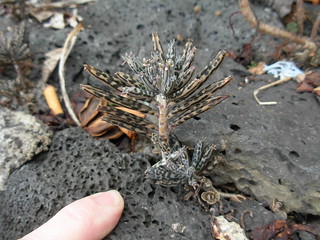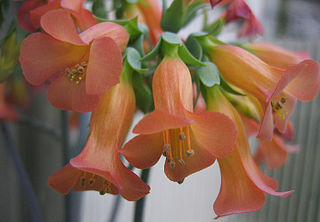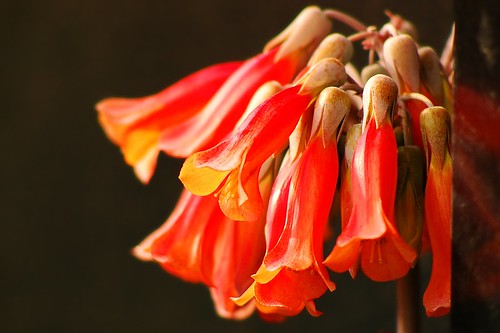Дата фото: 18.09.2011 | Фото Андрея Катровского
Смотреть больше подробностей/скачать обойный размер (1920х1280, 0,17 МБ).
Этот оригинальный суккулент — родом из каменистых пустынь Мадагаскара. В наш дом он попал довольно странно: с саженцем сирени. Каким-то образом стало очевидно, что климат под сиренью для этой диковинной штуки не годится, а вот в комнате она легко прижилась.
Растение относится к подроду Bryophyllum рода Kalanchoe. По-английски оно называется «растение-канделябр» (ну сами видите), а ещё — «мать тысяч» или «мать миллионов». Каждая «оборочка» на конце длинного листа — это маленькое растение, которое готово в любой момент спрыгнуть, вцепиться с землю маленькими корешками и резво рвануть вверх, порождая новые когорты покорителей земли.
 Фото: brewbooks @ flickrЦвет листьев варьирует от нежно-зелёного в полутени до тёмно-пятнистого серо-зелёного — если света много. Как раз под цвет родной местности.
Фото: brewbooks @ flickrЦвет листьев варьирует от нежно-зелёного в полутени до тёмно-пятнистого серо-зелёного — если света много. Как раз под цвет родной местности.
Корневая система у аскета небольшая — он привык жить среди камней, в т.ч. на лавовых полях, где почвы совсем мало; так что в небольшом горшке можно выращивать целый лес. У меня он вообще живёт «где попало» — зимой бродит по горшкам с другими растениями, летом — по теплице и клумбам. Что ему действительно нужно — это хороший свет. Лёгкое притенение на улице для него вполне комфортно, но под лампами он будет вытягиваться и терять декоративность. Зиму кое-как протянет, а вот летом необходима дача или солнечное окно.
 Фото: CactuspediaСверху тоже прикольно смотрится. Я вообще не понимаю, почему у меня так мало его фоток.
Фото: CactuspediaСверху тоже прикольно смотрится. Я вообще не понимаю, почему у меня так мало его фоток.
Толстые листья и сочный стебель позволяют канделябру без особого ущерба переживать месяц-другой засухи, а обильная быстрорастущая детва — стремительно осваивать новые территории, если обстоятельства сложились более-менее сносно. Стебли в природе достигают ~метровой высоты, а затем заваливаются набок и легко дают придаточные корни и новые побеги. Соответственно, черенковать его можно методом «нарубить и воткнуть». Вполне ожидаемо, что в некоторых тёплых областях земного шара (Австралия, тропические острова Тихого океана) этот каланхой является видом-агрессором. Но нашей северной природе он ничем не грозит, т.к. выдерживает температуры лишь до -1°C, так что можно смело выращивать его не только дома, но и летом на клумбе. Вот как раз с клумбы у меня его сейчас небольшой мешок.
 Фото: WikipediaЦвести оно тоже умеет, но у меня пока — ни разу.
Фото: WikipediaЦвести оно тоже умеет, но у меня пока — ни разу.
Конечно, чтобы не быть тотально съеденным и выпитым в условиях жёсткого дефицита воды суровой каланхоевой родины, такому сочному «салату» потребовались более веские аргументы, чем стремительное размножение. Их у него есть: скотина, отведав аппетитных канделябров, быстро подыхает от сердечной недостаточности. Более того, сообщается, что и люди, съевшие ту самую скотину, тоже заболевают. Кстати да, за все 7 лет нашего знакомства ни одна насекомая или грибная зараза к этой «вкусняшке» не прицепилась. Впрочем, каланхоэ напоминает нам, что разница между ядом и лекарством состоит в дозировке и способе употребления: есть данные о том, что растение может стать новым лекарством от рака, а где-то его применяют и в народной медицине.
Раздаю растения размером ~10-30 см с корнями, без горшков. Их можно будет начеренковать и натыкать в горшок, плюс детвы нападает, как обычно. За пару месяцев с хорошим светом можно сделать большой красивый куст.
каланхоэ трубчатоцветковое Kalanchoe tubiflora Kalanchoe delagoensis
Photo taken on Sep 18, 2011 | Photo by Andrei Katrovskiy
View more details/download wallpaper size (1920х1280, 0,17 M).
This odd-looking succulent is native to dry stony regions of Madagascar. We received it occasionally, with a lilac sapling. Somehow we understood that the unusual grass is not for our climate; but indoors it grew nicely.
The plant belongs to Bryophyllum section of genus Kalanchoe. Besides “chandelier”, it is called “mother of thousands” and “mother of millions”. Each “frill” at the end of the leaf is a small plantlet, always ready to land, sink it's roots into soil, grow rapidly and give birth to new cohorts of invaders.
 Photo from WikipediaLeaf color varies from fresh green in half-shadowy conditions to dappled grayish-green in sunny place. The latter corresponds to it's mother land.
Photo from WikipediaLeaf color varies from fresh green in half-shadowy conditions to dappled grayish-green in sunny place. The latter corresponds to it's mother land.
The roots are small, as plant is used to clinging to tiny patches of soil among stones, eg, in old lava flows. Sometimes my chandeliers even do not have their own pot — they just grow here and there in other plants' pots in winter and in flowerbeds in summer. What it really needs is sun. Light shadow is ok for the plant, but without sun, under artificial light it will soon loose it's showy appearance.
 Photo by Vietnam Plants & America plants @ flickrView from above is spectacular, too.
Photo by Vietnam Plants & America plants @ flickrView from above is spectacular, too.
With fleshy leaves and stems, the chandelier can withstand a couple of months' drought easily, while thousands of plantlets will not miss their chance when the conditions are livable. The stems grow up to about a meter and then they easily bend sideways and give additional roots and shoots. It can be easily planted with “cut in pieces and stick into soil” method. No wonder the species is considered invasive in a number of warm regions (Australia, Pacific islands). For our Nordic nature it's safe, as it can only withstand temperatures as low as -1°C.
 Photo by mugley @ flickrIt also can bloom nicely.
Photo by mugley @ flickrIt also can bloom nicely.
Of course, to avoid being totally eaten up in harsh conditions of desert, such juicy plant needs to have some weapons besides thousands of fast-growing children. And it has some: animals who try to chew the yummy leaves soon die from sudden heart failure. Moreover, secondary poisoning can occur in humans who eat meat from livestock that graze on K. delagoensis. That has a positive side for cultivation: since we met 7 years ago, I never saw any pests on the plant. But Kalanchoe also reminds us that difference between poison and medicine is dose and right usage: a study shows that it's a potential new anticancer agent candidate, and it's already used in some folk medicine.
hardy-1species Mother of thousands, mother of millions, chandelier plant Kalanchoe delagoensis